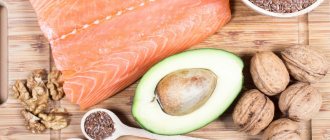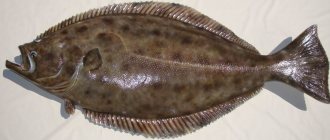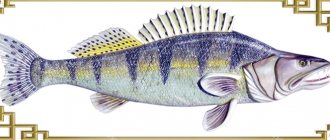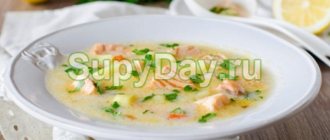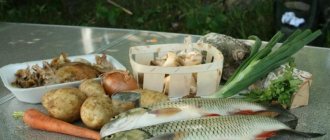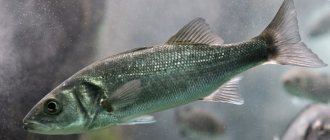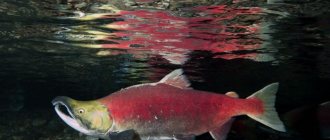Fish stock is usually made from various parts of the fish: fins, head and tail. In addition to fish, various spices, salt, dill and green onions are also added to this broth, which add aroma and a unique taste to the dish. Fish broth is an alternative to meat broth, especially during fasting. In order to get a nutritious and healthy broth, it must be prepared from pike perch, ruffe and sturgeon varieties of fish. Fish broth can be consumed as a main dish or as an addition to it. Soups and sauces are also cooked on its basis. What benefits can the use of fish broth provide for the body?
Benefits of fish broth:
This dish contains vitamins PP, H, C, B, E, as well as minerals: iodine, calcium, sodium, potassium, fluorine, zinc, phosphorus and iron. The usefulness of fish broth, as well as its calorie content, depends on the type of fish that is in it. The ease and speed of digestion of this dish is not affected by the fat content of the fish used. Therefore, it is advisable to use fish broth as food for children, athletes and people who have undergone serious operations. The broth normalizes the functioning of the digestive system. It is also useful for diseases of the gastrointestinal tract. Doctors also recommend that people with thyroid problems use it. This product helps maintain healthy teeth and bones, as well as avoid nervous system disorders. Fish broth is a source of strength and vigor. This dish leads to increased immunity and energy levels of the body. Broth has a positive effect on the metabolic process.
Fish broth for children and their parents
Pike perch, in addition to the above, is rich in amino acids (about 20 amino acids), which are so necessary for the body for muscle growth. Also, pike perch is the only fish that is allowed to be given to children as their first food.
Unfortunately, not everything is as good as it seems. Sturgeon, perch, and other types of fish also have negative properties, such as the accumulation of toxins and other harmful substances. Moreover, fish producers are trying in every possible way to improve the taste and visual qualities of the fish, again “pumping” the product with harmful substances. If you purchase frozen fish, you need to pay attention to the expiration date; if not frozen, then the fish must be fresh.
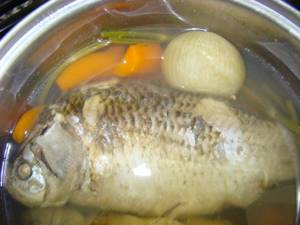
So, we have examined the beneficial and harmful properties of fish. All that remains is to combine this with our broth and this is what you get in the end: Pros of fish broth: 1. Ideal for those who monitor their weight and health.2. Rich in vitamins, minerals, fats and, most importantly, protein that are beneficial to the body.3. Positively affects the functioning of the gastrointestinal tract (gastrointestinal tract).4. Pike perch broth is recommended for people after operations and serious illnesses, as well as for children as a first food. Cons of fish broth: 1. Reduced overall usefulness of a dish due to the content of toxins and poisons in fish.2. Contraindicated for people with kidney, liver and cardiovascular diseases.
If you still decide to pamper yourself and your loved ones with fish broth or soup based on fish broth, pay attention not only to the freshness of the fish, but also to where it was produced (fish produced in artificial reservoirs or on farms is more harmful than fish grown in natural conditions, since it is no secret that fish farm owners add various additives to fish feed to accelerate growth, increase body weight, reduce diseases, etc.). Be healthy and eat healthy and wholesome food!
Performer Sidorova Irina Artyomovna (irinasii) OLYMPUS DIGITAL CAMERA
Harm from fish broth:
To prepare this dish, you must use fresh fish. To determine the freshness of a fish, you should examine its gills. They should be bright red or scarlet. It is more difficult to do this with frozen fish, so you need to look at the expiration date indicated on the package. Fish is a food that can cause an allergic reaction. Therefore, fish broth should not be consumed by people who are prone to allergies and the elderly. Various diseases of the liver, kidneys, as well as problems with the cardiovascular system are contraindications to eating fish broth. It is worth remembering that in addition to useful substances, fish may contain salts of harmful metals and toxic substances. This is usually found in fish that have been raised in artificial ponds.
Source https://am-am.su/1055-rybnyy-bulon.html
If we consider how many calories are in the ear, then depending on the type of fish, cooking method, as well as variations in ingredients, the nutritional value may vary.
Why should you be careful with river fish?
However, you should be careful when introducing fish into your child’s diet, as any type of this product can cause an allergic reaction. Do not also forget that fish may contain parasites, and before serving it, it is necessary to carry out appropriate heat treatment. Eating raw fish is dangerous!
Also, the quality and beneficial properties of fish can undoubtedly be negatively affected by its habitat. Fish is capable of accumulating heavy metals and other dangerous substances, therefore, in order for the fish consumed as food to prolong life and improve health, you should carefully choose this product when purchasing.
Wow, what kind of dish is this?
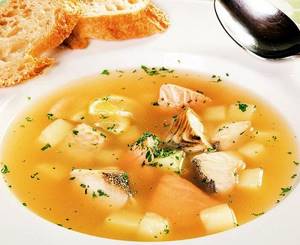
Several centuries ago, fish soup meant ordinary soup, made from anything, not just fish. Today, almost everyone knows that fish soup is very healthy and an essential component of the dish is fish. There are many recipes, of which the classic version of the decoction stands out. It involves the use of fish with such characteristics as a sweetish taste, freshness, and “stickiness.” Compliance with these requirements helps to obtain an exceptional taste and low energy
value of such a dish
. Therefore, eating fish soup during a diet is not only allowed, but also recommended.
The classic ear also has its own classification, according to which it stands out:
- Black ear, the calorie content of which is considered one of the lowest and varies around 31-40 kcal. The name itself is associated with the slight cloudiness of the broth, although in some recipes cucumber brine is added specifically for this purpose. Mostly river fish such as crucian carp, carp, rudd, as well as carp and asp are used for cooking. For comparison, the calorie content of carp fish soup is 31.57 kcal, but if the broth is prepared from crucian carp, the dish will become a little more nutritious. Calorie content of crucian fish soup is approximately 39.57 kcal
- White ear. For classic white fish soup, whitefish, pike perch, as well as ruff and perch are taken. For the best aroma and taste, other varieties are added, in particular, tench, catfish, and ide. Usually this is no more than 35% of all fish. This is especially important when observing the nutritional limits of a dish, since, for example, the calorie content of tench fish is 84.27 kcal, which will also affect the overall energy indicators;
- Triple ear. The methods for preparing the broth are different, as you can improvise with different types of fish. You can use one type of fish for cooking, and another for consumption. This option is especially good when you are on an ear diet and the kcal content is important;
- Red ear. From the name it is clear that this is red fish soup, the caloric content of which can also be regulated, the average is about 63.79 kcal. The dish is not exactly budget-friendly, but healthy and unusual in taste. Naturally, a lot depends on the cooking technology and type of seafood; for example, the calorie content of salmon fish soup can be only 38.87 kcal.
Secrets of cooking fish dishes
To make the fish broth tasty and aromatic, it is worth considering several nuances:
- During the cooking process, you must take into account how long the type of fish you use needs to be cooked.
- After cooking, strain the broth to remove small bones. It is advisable to repeat the procedure 2 times.
- When using river fish, water can be replaced with cucumber brine. The marinade will muffle the bright smell of the main product.
- To make the broth transparent, you should remove all the fat from the fish carcass. If this does not help, at the end of cooking you will need to draw off the broth.
- During the cooking process, you need to constantly remove the foam that collects on the surface of the water at the moment of boiling.
If you take into account all the recommendations, the broth will turn out to be appetizing in appearance, tasty and aromatic. Another guarantee of the quality of the dish will be the choice of fish. The resulting broth can be used as a base for other dishes or as an independent option. Such a menu item can significantly diversify the diet of a person who needs to eat nutritious and healthy dishes.
Unusual types of fish broths
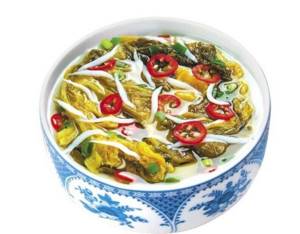
Above we discussed the classic version of the decoction, that is the name, and not the soup, since true cooks know the main differences. These include a minimum of vegetables, a variety of seasonings, onions, black pepper are required, sometimes tarragon, ginger, garlic, and other spices. The calorie content of fish soup prepared according to the classical method is usually low.
Unusual fish soup recipes include:
- Stock of dried fish, seasoned with mushrooms. It is difficult to calculate how many kcal there are in an ear of this type, since combining such different components in each case gives its own results;
- Baked fish soup or with egg. This dish has certain features, and the option of simply adding an egg to the broth is a simplified method. You should remove the cooked fish, make it like a batter, fry it and put it back into the broth. You can also bake in a pot, when the egg evenly covers the broth. This trout fish soup is especially tasty, the calorie content of which does not exceed 38.32 kcal;
- Ukha is poured or prepared from noble varieties of fish, for example, sturgeon, in particular sterlet. The fish is not gutted, it must be alive and it is not boiled, but brewed, then all the ingredients are poured with boiling water. If you consider sterlet fish soup, the calorie content of this dish can reach up to 146.1 kcal;
Decoctions can be supplemented with vodka, which is more typical for a fishing recipe, as well as salted mushrooms, crayfish, lard, burbot liver, plenty of carrots, tomatoes and many other products that are not associated with classical ideas about fish soup. Sometimes fish varieties that have a specific aroma are used, for example, herring, mackerel. Moreover, the calorie content of mackerel soup is 26.61 kcal and the dish is not so common, but in demand. Therefore, fish lovers should not stop at just adding spices and potatoes. By the way, if you compare such an indicator as calorie soup with potatoes and with carrots, then the latter option is the most dietary.
Classic fish broth recipe
There is a huge variety of recipes for preparing the decoction. Each option has its own differences, determined by the nationality of the cuisine. The simplest recipe to prepare is the classic recipe. The nuances can only relate to the peculiarities of preparing the type of fish. A standard set of products can be used.
You need to prepare the following ingredients:
- 500 g carcass;
- 1 large onion;
- small parsley root;
- 3 liters of water.
Additionally, you need to prepare salt and ground black pepper. This amount of food should yield 6 servings.
Why is ear useful?
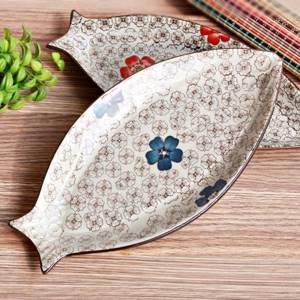
Fish is initially a very healthy product. Content of minerals, fats
,
proteins and other equally important compounds depends on the type of fish, place of catch, and method of preparation
. Sea fish can become especially valuable, since in addition to easily digestible substances, it contains enough iodine and phosphorus. For example, cod fish soup, with a calorie content of 24.06 kcal, will be an excellent addition to any diet, just like a decoction of other types of fish products. The best option is hot soup.
Source https://kalory.ru/Ryibnyie-dietyi/id/1126-Kaloriynost-v-uhe-i-Kaloriynost-uha.html
Ear for weight loss
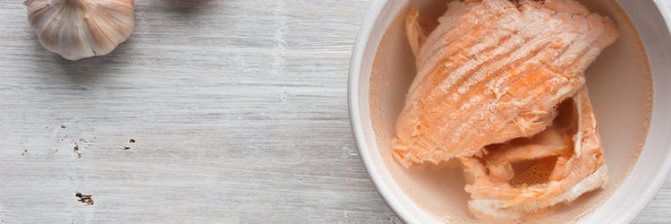
Diet soup is an excellent choice for those who decide to lose weight and go on a diet. A traditional Russian dish is prepared using a broth made from various varieties of river and sea fish. And, as you know, it is an indispensable product for proper nutrition and getting slim.
Fish broth - salvation from diseases! Let's cook it right!
To make the broth truly healthy, it is important to choose the right fish for its preparation. It is better to give preference to low-fat sea fish - halibut, cod, flounder, sea bass. It is undesirable to use fish from the salmon family, since during long heat treatment the fat will easily oxidize.
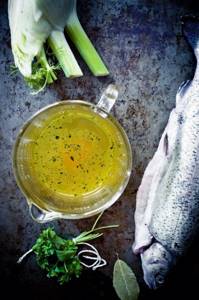
According to popular belief, fish broth can cure a person of all diseases. Even 2000 years ago, our ancestors used this dish to obtain energy, restore strength, activate mental activity, rejuvenate the body and restore male strength. They say that the broth also helped seriously ill and dying people. Considering these facts, you should definitely include this dish in your diet; you are guaranteed to feel the difference in your energy levels and overall well-being.
Useful properties of fish
Fish is the most important ingredient in fish soup. It not only contains easily digestible protein so necessary for our body, but is also rich in minerals.
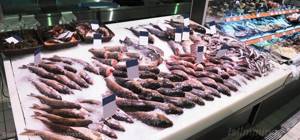
Useful properties of fish:
- is absorbed much better than any, even dietary meat;
- The greatest value is the content of omega-3 and omega-6 saturated fatty acids, which the body cannot produce itself, but needs them daily. They help lower blood cholesterol levels, are necessary for brain function, and reduce the risk of heart disease;
- Another great advantage of it is that it promotes the production of collagen and proteins, which play an important role in losing weight. Collagen will help the skin remain smooth and elastic after dieting, and not hang in wrinkled folds. Just eat fish soup along with boiled bones more often - and the result will be obvious;
- Despite the abundance of nutrients, fats, vitamins and minerals, fish remains a low-calorie product. This makes it indispensable if you want to lose weight.
The benefits of fish soup for weight loss
Fish soup is a great way to lose weight quickly and tasty. It, like any dietary fish dish, is low in calories. This allows you to eat it with virtually no restrictions and at the same time lose excess weight.
- Preparing the dish does not require a large number of ingredients, so you can easily count the calories it contains.
- A properly prepared dish turns out transparent, beautiful, very tasty and light.
- The ear diet differs from any soup diet in its low calorie content and huge content of nutrients.
- If you prepare fish soup according to all dietary rules, then it turns out not only tasty, but easy to prepare and inexpensive.
- You can arrange fasting days on the ear. This is also very useful for those who suffer from diseases of the gastrointestinal tract or diabetes.
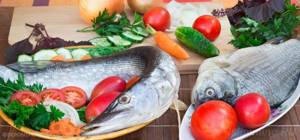
Varieties
A dish is prepared from various parts of a large river or sea carcass. Not every type is suitable for creating a healthy and low-calorie fish broth. The optimal nutritional option is broth, which contains from 2 to 6 calories per 100 g of product. You can prepare yushka from almost any type of fish, but there are exceptions and recommendations:
- It is not advisable to use mackerel or herring varieties.
- You should not use river fish that lived in silted reservoirs.
- The ideal option is white sturgeon meat.
- The decoction will be tasty if you prepare it from burbot, tench, and pike perch.
- Red fish (sturgeon, stellate sturgeon, lean parts of salmon) is also suitable.
You can cook broth from any part of the fish: head, fins, ridge, tail. It is important to prepare products well. Small fish and large steaks are the best options for creating a very tasty fish soup.

Rich decoctions are made from pike perch, ruffe or perch. When using carp, pike perch or carp, you may get a bitter aftertaste.
Diet soup for weight loss. Cooking secrets
How to cook a low-calorie dish correctly?
There are several secrets for this:
- First of all, you should exclude fatty fish from the recipe - mackerel, salmon, all sturgeon varieties, saury, etc. It is better to use river varieties - perch, bream, ruffe, pike perch. Then the dish will have an extraordinary aroma and taste;
- give preference to fresh fish. But if you have fresh frozen food, then cook it immediately by removing the product from the freezer without defrosting.
- It is advisable not to use potatoes. But 2 - 3 small potatoes can still be added to give the broth flavor and richness;
- carrots and onions are essential ingredients for real fish soup;
- don't forget about spices, herbs and herbs. These are very important components of the dish. They give a unique aroma that you can create to your taste. Usually this is bay leaf, peppercorns. Celery, dill, parsley, and pepper mixtures go well with the fishy aroma;
- The soup is best served hot. In this form, it retains not only its taste, but also all its beneficial properties.
Fish broth - several recipes for health
- The most nutritious dish
- Fish heads are the most valuable raw material
- Classic recipe
- Simple recipe
- Quick recipe - replacement, but not an alternative to broth
- Recipe for vegetarians
The most nutritious dish
Inexpensive and easy to prepare, fish broth is valued primarily due to the presence of minerals beneficial to the body , which, along with vitamins, are essential components of enzymes. The mineral composition of blood serum is similar to sea water, which is why the broth replenishes the lack of nutrients in a sick body.
Ear for weight loss from river fish. Recipe and video
Use regular, mirror carp or crucian carp.
- carp weighing 1 kg;
- onions – 2 heads;
- carrot – 1 pc.
- millet – half a glass;
- water – 5 liters.
- Boil the fish until it is ready to fall off the bones.
- Finely chop the onion and carrot;
- rinse the millet and add to the boiling broth;
- after 10 minutes, throw in the carrots and onions;
- add black peppercorns;
- You can add one or two coarsely chopped potatoes.
- before removing from the heat, add the deboned carp;
- Before serving, add fresh finely chopped dill.

Ear soup for weight loss with celery. Recipe and video
It satisfies perfectly, while being low in calories and tasty.
- any lean fish – 1.3 kg;
- celery root – 1 pc.
- water – 2 liters;
- purple onion – 1 pc.;
- carrot - 1 pc.;
- parsley, dill - half a bunch;
- bay leaf - a couple of leaves;
- a mixture of salt and ground pepper - to taste.
- Wash the celery root, peel and cut into cubes;
- Chop the onion and carrots too;
- add celery, onion and carrots to boiling water;
- cut the fish into fillets and cut into portions;
- after 10 minutes add fish fillet and spices;
- turn off the heat after a few minutes.
- serve hot.
Using recipes, preparing a light, low-calorie, tasty dish is very easy and inexpensive. You can treat yourself to it without the risk of getting extra calories.
Source https://slimim.com/23973/uha/
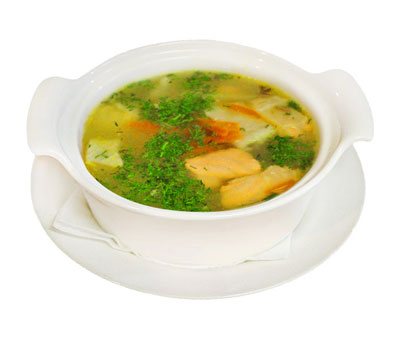
Ukha is a traditional Russian first dish. In ancient times, fish soup was the name given to any first course, regardless of the basis on which it was prepared. Starting from the 18th century, fish soup began to be called the first dish prepared exclusively on the basis of fish.
In modern cooking, ukha is considered a unique fish dish. Depending on the method of preparation and its contents, this dish is classified into different types. There are many recipes for preparing this dish, which allows you to significantly diversify the diet of any person.
The nutritional value
Vitamins
- PP Vitamin PP 0.01 mg
- B1 Vitamin B1 0.001 mg
- B2 Vitamin B2 0.001 mg
- B6 Vitamin B6 0.006 mg
- B9 Vitamin B9 0.3 mcg
- C Vitamin C 0.2 mg
- E (TE) Vitamin E (TE) 0.001 mg
- H Vitamin H 0.007 mcg
- PP Vitamin PP (NE) 1.6202 mg
Macronutrients
- Fe Iron 0.01 mg
- Zn Zinc 0.243 mg
- I Iodine 0.02 mcg
- Cu Copper 0.7 mg
- Mn Manganese 0.0019 mg
- Cr Chromium 18.6 mcg
- F Fluorine 145.2 mcg
- Mo Molybdenum 1.3 µg
- B Boron 1.7 µg
- Co Cobalt 0.04 mcg
- Al Aluminum 3.3 µg
- Ni Nickel 2 µg
- Rb Rubidium 4 mcg
Calorie content of fish soup
Ukha is a medium calorie dish. Its energy value averages 72 kcal. The highest calorie soup is considered to be fish soup with quenelles or pies - 85 kcal.
The nutritional value of such first courses is quite high. Most of it is occupied by proteins, since the main raw material for preparing fish soup is fish of various varieties. The ratio of main nutrients has the following averages:
- Proteins - 10.5 g.
- Fats - 1.7 g.
- Carbohydrates - 2.9 g.
The energy and nutritional value of fish soup directly depends on the type of fish used for its preparation and other additional ingredients in the form of vegetables and spices.
Recipe for river fish soup. Calorie, chemical composition and nutritional value.
Nutritional value and chemical composition of “river fish soup”.
The table shows the nutritional content (calories, proteins, fats, carbohydrates, vitamins and minerals) per 100 grams of edible portion.
| Nutrient | Quantity | Norm** | % of the norm in 100 g | % of the norm in 100 kcal | 100% normal |
| Calorie content | 26.7 kcal | 1684 kcal | 1.6% | 6% | 6307 g |
| Squirrels | 3.1 g | 76 g | 4.1% | 15.4% | 2452 g |
| Fats | 0.4 g | 56 g | 0.7% | 2.6% | 14000 g |
| Carbohydrates | 2.7 g | 219 g | 1.2% | 4.5% | 8111 g |
| Organic acids | 0.1 g | ~ | |||
| Alimentary fiber | 0.5 g | 20 g | 2.5% | 9.4% | 4000 g |
| Water | 91.2 g | 2273 g | 4% | 15% | 2492 g |
| Ash | 0.395 g | ~ | |||
| Vitamins | |||||
| Vitamin A, RE | 124.3 mcg | 900 mcg | 13.8% | 51.7% | 724 g |
| beta carotene | 0.745 mg | 5 mg | 14.9% | 55.8% | 671 g |
| beta Cryptoxanthin | 0.0446 µg | ~ | |||
| Lycopene | 0.0056 µg | ~ | |||
| Lutein + Zeaxanthin | 0.1905 mcg | ~ | |||
| Vitamin B1, thiamine | 0.019 mg | 1.5 mg | 1.3% | 4.9% | 7895 g |
| Vitamin B2, riboflavin | 0.013 mg | 1.8 mg | 0.7% | 2.6% | 13846 g |
| Vitamin B4, choline | 0.15 mg | 500 mg | 333333 g | ||
| Vitamin B5, pantothenic | 0.054 mg | 5 mg | 1.1% | 4.1% | 9259 g |
| Vitamin B6, pyridoxine | 0.048 mg | 2 mg | 2.4% | 9% | 4167 g |
| Vitamin B9, folates | 1.942 mcg | 400 mcg | 0.5% | 1.9% | 20597 g |
| Vitamin C, ascorbic acid | 2.88 mg | 90 mg | 3.2% | 12% | 3125 g |
| Vitamin E, alpha tocopherol, TE | 0.049 mg | 15 mg | 0.3% | 1.1% | 30612 g |
| gamma tocopherol | 0.0042 mg | ~ | |||
| delta tocopherol | 0.0001 mg | ~ | |||
| Vitamin H, biotin | 0.102 mcg | 50 mcg | 0.2% | 0.7% | 49020 g |
| Vitamin K, phylloquinone | 1 mcg | 120 mcg | 0.8% | 3% | 12000 g |
| Vitamin RR, NE | 0.7352 mg | 20 mg | 3.7% | 13.9% | 2720 g |
| Niacin | 0.203 mg | ~ | |||
| Betaine | 0.0083 mg | ~ | |||
| Macronutrients | |||||
| Potassium, K | 78.96 mg | 2500 mg | 3.2% | 12% | 3166 g |
| Calcium, Ca | 9.66 mg | 1000 mg | 1% | 3.7% | 10352 g |
| Magnesium, Mg | 6.41 mg | 400 mg | 1.6% | 6% | 6240 g |
| Sodium, Na | 62.66 mg | 1300 mg | 4.8% | 18% | 2075 g |
| Sera, S | 35 mg | 1000 mg | 3.5% | 13.1% | 2857 g |
| Phosphorus, P | 13.3 mg | 800 mg | 1.7% | 6.4% | 6015 g |
| Chlorine, Cl | 125.97 mg | 2300 mg | 5.5% | 20.6% | 1826 |
| Microelements | |||||
| Aluminium, Al | 124.7 mcg | ~ | |||
| Bor, B | 23.1 mcg | ~ | |||
| Vanadium, V | 13.84 mcg | ~ | |||
| Iron, Fe | 0.231 mg | 18 mg | 1.3% | 4.9% | 7792 g |
| Yod, I | 0.71 mcg | 150 mcg | 0.5% | 1.9% | 21127 g |
| Cobalt, Co | 0.853 mcg | 10 mcg | 8.5% | 31.8% | 1172 g |
| Lithium, Li | 7.526 mcg | ~ | |||
| Manganese, Mn | 0.0442 mg | 2 mg | 2.2% | 8.2% | 4525 g |
| Copper, Cu | 21.35 mcg | 1000 mcg | 2.1% | 7.9% | 4684 g |
| Molybdenum, Mo | 1.533 mcg | 70 mcg | 2.2% | 8.2% | 4566 g |
| Nickel, Ni | 1.579 mcg | ~ | |||
| Rubidium, Rb | 75.9 mcg | ~ | |||
| Selenium, Se | 0.126 mcg | 55 mcg | 0.2% | 0.7% | 43651 g |
| Fluorine, F | 133.26 mcg | 4000 mcg | 3.3% | 12.4% | 3002 g |
| Chromium, Cr | 9.57 mcg | 50 mcg | 19.1% | 71.5% | 522 g |
| Zinc, Zn | 0.2042 mg | 12 mg | 1.7% | 6.4% | 5877 g |
| Digestible carbohydrates | |||||
| Starch and dextrins | 1.573 g | ~ | |||
| Mono- and disaccharides (sugars) | 1.1 g | max 100 g | |||
| Glucose (dextrose) | 0.2911 g | ~ | |||
| Sucrose | 0.6751 g | ~ | |||
| Fructose | 0.1456 g | ~ | |||
| Essential amino acids | 0.1039 g | ~ | |||
| Arginine* | 0.0217 g | ~ | |||
| Valin | 0.0155 g | ~ | |||
| Histidine* | 0.0045 g | ~ | |||
| Isoleucine | 0.0126 g | ~ | |||
| Leucine | 0.0177 g | ~ | |||
| Lysine | 0.0186 g | ~ | |||
| Methionine | 0.0036 g | ~ | |||
| Methionine + Cysteine | 0.0071 g | ~ | |||
| Threonine | 0.0135 g | ~ | |||
| Tryptophan | 0.0043 g | ~ | |||
| Phenylalanine | 0.0136 g | ~ | |||
| Phenylalanine+Tyrosine | 0.0251 g | ~ | |||
| Nonessential amino acids | 0.1868 g | ~ | |||
| Alanin | 0.0156 g | ~ | |||
| Aspartic acid | 0.0359 g | ~ | |||
| Glycine | 0.0136 g | ~ | |||
| Glutamic acid | 0.0525 g | ~ | |||
| Proline | 0.0123 g | ~ | |||
| Serin | 0.0156 g | ~ | |||
| Tyrosine | 0.0113 g | ~ | |||
| Cysteine | 0.0037 g | ~ | |||
| Sterols (sterols) | |||||
| Phytosterols | 0.0855 mg | ~ | |||
| Saturated fatty acids | |||||
| 12:0 Lauric | 0.0002 g | ~ | |||
| 14:0 Miristinovaya | 0.0003 g | ~ | |||
| 16:0 Palmitinaya | 0.0078 g | ~ | |||
| 18:0 Stearic | 0.0014 g | ~ | |||
| Monounsaturated fatty acids | 0.0169 g | min 16.8 g | 0.1% | 0.4% | |
| 16:1 Palmitoleic | 0.0005 g | ~ | |||
| 18:1 Oleic (omega-9) | 0.0163 g | ~ | |||
| Polyunsaturated fatty acids | 0.0094 g | from 11.2 to 20.6 g | 0.1% | 0.4% | |
| 18:2 Linolevaya | 0.0087 g | ~ | |||
| 18:3 Linolenic | 0.0081 g | ~ |
The energy value of river fish ear is 26.7 kcal.
Primary Source: Created in the application by the user. Read more.
** This table shows the average levels of vitamins and minerals for an adult. If you want to know the norms taking into account your gender, age and other factors, then use the “My Healthy Diet” application.
